Passer
Passer is a genus of sparrows, also known as the true sparrows. The genus contains 28 species and includes the house sparrow and the Eurasian tree sparrow, two of the most common birds in the world. They are small birds with thick bills for eating seeds, and are mostly coloured grey or brown. Native to the Old World, some species have been introduced throughout the world.
| Passer | |
|---|---|
.jpg.webp) | |
| Male Cape sparrows in Namibia | |
| Scientific classification | |
| Domain: | Eukaryota |
| Kingdom: | Animalia |
| Phylum: | Chordata |
| Clade: | Dinosauria |
| Class: | Aves |
| Order: | Passeriformes |
| Family: | Passeridae |
| Genus: | Passer Brisson, 1760 |
| Type species | |
| Fringilla domestica[1] Linnaeus, 1758 | |
| Species | |
|
See text. | |
| Synonyms | |
Taxonomy
The genus Passer was introduced by the French zoologist Mathurin Jacques Brisson in 1760.[2][3] The type species was subsequently designated as the house sparrow (Passer domesticus).[3][4] The name Passer is the Latin word for "sparrow."[5]
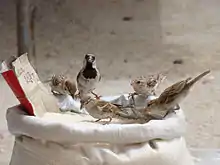
Studies by Arnaiz-Villena et al. have examined the evolutionary relationships of the genus Passer with other members of the family Passeridae, and of members of the genus in relation to each other. According to a study by Arnaiz Villena et al. published in 2001, the genus originated in Africa and the Cape sparrow is the most basal lineage. The particular lineages within the genus, such as the house sparrow and other Palaearctic black-bibbed sparrows, likely originate from radiations from southern and western Africa.[6][7]
Species
The genus contains 28 species:[8][9]
| Image | Common Name | Scientific name | Distribution |
|---|---|---|---|
.jpg.webp) |
Cape sparrow | Passer melanurus | central coast of Angola to eastern South Africa and Swaziland |
 |
Chestnut sparrow | Passer eminibey | Darfur in Sudan to Tanzania |
| Kordofan sparrow | Passer cordofanicus | South Sudan and Chad | |
.jpg.webp) |
Shelley's sparrow | Passer shelleyi | eastern Africa from South Sudan, southern Ethiopia, and north-western Somalia to northern Uganda and north-western Kenya |
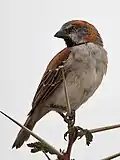 |
Kenya sparrow | Passer rufocinctus | Kenya and Tanzania |
%252C_Passer_motitensis_at_Marakele_National_Park%252C_South_Africa_(7796691488).jpg.webp) |
Great sparrow | Passer motitensis | southern Africa |
.jpg.webp) |
Northern grey-headed sparrow | Passer griseus | tropical Africa |
.jpg.webp) |
Swainson's sparrow | Passer swainsonii | northeastern Africa |
.jpg.webp) |
Swahili sparrow | Passer suahelicus | southern Kenya and Tanzania |
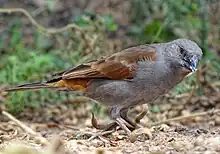 |
Parrot-billed sparrow | Passer gongonensis | eastern Africa |
.jpg.webp) |
Southern grey-headed sparrow | Passer diffusus | Angola and Zambia southwards into South Africa |
-_Male_at_Sultanpur_I_Picture_178.jpg.webp) |
Sind sparrow | Passer pyrrhonotus | Indus valley region in South Asia |
_I_IMG_6779-crop.jpg.webp) |
Russet sparrow | Passer cinnamomeus | southeastern Tibet, Bhutan, Sikkim, Nepal, Uttarakhand, and Himachal Pradesh to Kashmir and Nuristan in Afghanistan |
 |
Eurasian tree sparrow | Passer montanus | Temperate Eurasia and Southeast Asia. Introduced in Sardinia, eastern Indonesia, the Philippines, Micronesia, Victoria and New South Wales in Australia and the U.S. states of Missouri, Illinois and Iowa. |
.jpg.webp) |
Saxaul sparrow | Passer ammodendri | Central Asia |
.jpg.webp) |
Plain-backed sparrow | Passer flaveolus | Myanmar to central Vietnam, and south to the western part of Peninsular Malaysia |
 |
Abd al-Kuri sparrow | Passer hemileucus | Abd al Kuri in the Socotra archipelago |
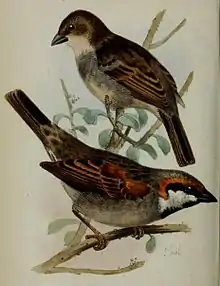 |
Socotra sparrow | Passer insularis | islands of Socotra, Samhah, and Darsah |
 |
Spanish sparrow | Passer hispaniolensis | Mediterranean region, Macaronesia and south-west and central Asia |
.jpg.webp) |
Italian sparrow | Passer italiae | northern and central Italy, Corsica, and small parts of France, Switzerland, Austria, and Slovenia |
.jpg.webp) |
House sparrow | Passer domesticus | Middle East, Eurasia and parts of North Africa. Introduced in subarctic North America, southern South America, southern Africa, eastern Australia, New Zealand and Hawaii |
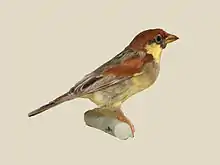 |
Somali sparrow | Passer castanopterus | northern Somalia, Djibouti, Ethiopia and Kenya. |
 | Iago sparrow | Passer iagoensis | archipelago of Cape Verde |
.jpg.webp) | Desert sparrow | Passer simplex | Sahara Desert of northern Africa |
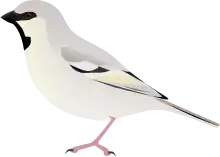 | Zarudny's sparrow | Passer zarudnyi | Uzbekistan and Turkmenistan |
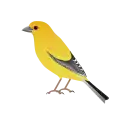 | Arabian golden sparrow | Passer euchlorus | south west Arabia and also the coast of Somalia and Djibouti |
 | Sudan golden sparrow | Passer luteus | sub-Saharan Africa |
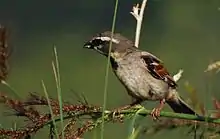 | Dead Sea sparrow | Passer moabiticus | Middle East and another in western Afghanistan and eastern Iran |
Besides these living species, there are questionable fossils from as long ago as the Early Miocene,[10] and Passer predomesticus, from the Middle Pleistocene.
Description
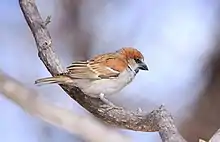
These sparrows are plump little brown or greyish birds, often with black, yellow or white markings. Typically 10–20 centimetres (3.9–7.9 in) long, they range in size from the chestnut sparrow (Passer eminibey), at 11.4 centimetres (4.5 in) and 13.4 grams (0.47 oz), to the parrot-billed sparrow (Passer gongonensis), at 18 centimetres (7.1 in) and 42 grams (1.5 oz).[11][12] They have strong, stubby conical beaks with decurved culmens and blunter tips.[13] All species have calls similar to the house sparrow's chirrup or tschilp call, and some, though not the house sparrow, have elaborate songs.
Distribution
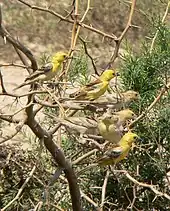
Most of its members are found naturally in open habitats in the warmer climates of Africa and southern Eurasia. Evolutionary studies suggest the genus originated in Africa.[6] Several species have adapted to human habitation, and this has enabled the house sparrow in particular, in close association with humans, to extend its Eurasian range well beyond what was probably its original home in the Middle East.[14] Apart from this natural colonisation, the house sparrow has been introduced to many parts of the world outside its natural range, including the Americas, sub-Saharan Africa, and Australia. The Eurasian tree sparrow has also been artificially introduced on a smaller scale, with populations in Australia and locally in Missouri and Illinois in the United States.[14]
Behaviour
Passer sparrows build an untidy nest, which, depending on species and nest site availability, may be in a bush or tree, a natural hole in a tree, in a building or in thatch, or in the fabric of the nest of species such as the white stork. The clutch of up to eight eggs is incubated by both parents typically for 12–14 days, with another 14–24 more days to fledging.
Passer sparrows are primarily ground-feeding seed-eaters, though they also consume small insects especially when breeding. A few species, like the house sparrow and northern grey-headed sparrow scavenge for food around cities, and are almost omnivorous.[15] Most Passer species are gregarious and will form substantial flocks.[11]
References
- "Passeridae". aviansystematics.org. The Trust for Avian Systematics. Retrieved 2023-07-16.
- Brisson, Mathurin Jacques (1760). Ornithologie, ou, Méthode contenant la division des oiseaux en ordres, sections, genres, especes & leurs variétés (in French and Latin). Vol. 1. Paris: Jean-Baptiste Bauche. p. 36, Pl. 1 fig. 6.
- Mayr, Ernst; Greenway, James C. Jr, eds. (1962). Check-list of birds of the world. Vol. 15. Cambridge, Massachusetts: Museum of Comparative Zoology. p. 8.
- Gray, George Robert (1840). A List of the Genera of Birds : with an Indication of the Typical Species of Each Genus. London: R. and J.E. Taylor. p. 46.
- Jobling, James A. (2010). The Helm Dictionary of Scientific Bird Names. London, United Kingdom: Christopher Helm. p. 294. ISBN 978-1-4081-2501-4.
- Allende, Luise M.; Rubio, Isabel; Ruiz del Valle, Valentin; Guillén, Jesus; Martínez-Laso, Jorge; Lowy, Ernesto; Varela, Pilar; Zamora, Jorge; Arnaiz-Villena, Antonio (2001). "The Old World sparrows (genus Passer) phylogeography and their relative abundance of nuclear mtDNA pseudogenes" (PDF). Journal of Molecular Evolution. 53 (2): 144–154. Bibcode:2001JMolE..53..144A. CiteSeerX 10.1.1.520.4878. doi:10.1007/s002390010202. PMID 11479685. S2CID 21782750. Archived from the original (PDF) on 21 July 2011.
- Arnaiz-Villena, A; Gómez-Prieto P; Ruiz-de-Valle V (2009). "Phylogeography of finches and sparrows". Animal Genetics. Nova Science Publishers. ISBN 978-1-60741-844-3. Archived from the original on 2012-09-02. Retrieved 2014-12-05.
- Gill, Frank; Donsker, David; Rasmussen, Pamela, eds. (January 2021). "Old World sparrows, snowfinches, weavers". IOC World Bird List Version 11.1. International Ornithologists' Union. Retrieved 1 June 2021.
- "Taxonomic Updates – IOC World Bird List". Retrieved 2021-07-29.
- Mlíkovský 2002, p. 247
- Clement, Harris & Davis 1993, p. 442
- Bledsoe, A. H.; Payne, R. B. (1991). Forshaw, Joseph (ed.). Encyclopaedia of Animals: Birds. London: Merehurst Press. p. 222. ISBN 978-1-85391-186-6.
- Groschupf, Kathleen (2001). "Old World Sparrows". In Elphick, Chris; Dunning, John B. Jr.; Sibley, David (eds.). The Sibley Guide to Bird Life and Behaviour. London: Christopher Helm. pp. 562–564. ISBN 978-0-7136-6250-4.
- Summers-Smith, J. D. (1990). "Changes in distribution and habitat utilisation by members of the genus Passer". In Pinowski, J.; Summers-Smith, J. D. (eds.). Granivorous birds in the agricultural landscape. Warszawa: Pánstwowe Wydawnictom Naukowe. pp. 11–29. ISBN 978-83-01-08460-8.
- Summers-Smith 1988, pp. 253–255
- Works cited
- Clement, Peter; Harris, Alan; Davis, John (1993). Finches and Sparrows: an Identification Guide. Princeton, New Jersey: Princeton University Press. ISBN 978-0-691-03424-9.
- Mlíkovský, Jiří (2002). Cenozoic Birds of the World, Part 1: Europe (PDF). Ninox Press. OCLC 156629447. Archived from the original (PDF) on 11 June 2007.
- Summers-Smith, J. Denis (1988). The Sparrows: a study of the genus Passer. illustrated by Robert Gillmor. Calton, Staffs, England: T. & A. D. Poyser. ISBN 978-0-85661-048-6.
External links
- Passeridae on the Internet Bird Collection
- Päckert, Martin; Hering, Jens; Belkacem, Abdelkrim Ait; Sun, Yue-Hua; Hille, Sabine; Lkhagvasuren, Davaa; Islam, Safiqul; Martens, Jochen (31 May 2021). "A revised multilocus phylogeny of Old World sparrows (Aves: Passeridae)". Vertebrate Zoology. 71: 353–366. doi:10.3897/vz.71.e65952. S2CID 236414823.